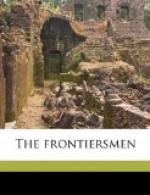It has been inferred that Adair is mistaken in his assertion that by the Indian law the chungke stones were exempt from burial with the effects of the dead, since certain of the most perfect specimens known to modern archaeological collections were found in the exploration of mounds in the valley of the Tennessee River. By many these mounds are supposed to be prehistoric, and the game is doubtless of an unimaginable antiquity. As late as his day, among the Cherokees; 1736, the stones were kept with the “strictest religious care,” and were the property of the town where the game was played.
Adair, despite his roving life, had evidently scant sympathy with athletics. He may have been growing old and indolent when he speaks of the game as a “task of stupid drudgery” and opines that instead of a sport it might “with propriety of language” be described as “running hard labor.” Other eye-witnesses, however, vaunt the great beauty and grace of the game. Captain Bernard Romany chronicles with relish the dexterity requisite, the great strength and skill displayed by the participants in the violent exercise, although demurely moralizing the while on its perilous fascination to both players and spectators, by reason of the inordinate temptation presented by its doubtful chances to the reckless gambler. Lieutenant Timberlake alone calls it “nettecawaw.”
As there are moot points concerning the stones themselves and the conduct of the sport, so the chungke spears differ in the accounts of the early adventurers in this region. The length is variously given as eight, ten, twelve feet. The shape is sometimes represented as a lance or pole heavy in the centre and tapering at both ends to a blunt point, and others describe an implement resembling a magnified golf club of the present day.
3. Page 114. This choice decoration, popular though it was, could not be attained without a penalty commensurate with its valuation. It is stated by early travelers among the Indian tribes that thirty days were required to properly heal an ear thus distended a la mode. The patient, if one so prideful might be so called, could only have one ear in the painful process at a time, in order that he might be able to lie in sleeping on the other side until such time as his embellished ear should be again serviceable for this prosaic purpose, and permit the like decoration of the opposite member.
4. Page 142. An illustration of how the Choctaws profited by these earnest labors may be given in the fate of a chapel erected for their benefit at Chickasaha by the French and placed in charge of a Jesuit missionary. The Choctaws so far accepted Christianity as to be able to travesty the services and mimic the priest with surprising humor and verisimilitude when the English came in, and were wont to go to the old chapel for this profane exhibition to the mingled delight and reprobation of the military new-comers. The chapel was soon afterward destroyed, but Captain Romans records that in 1771 he saw the cross still standing on the site, a melancholy memorial of futile missionary endeavor.




